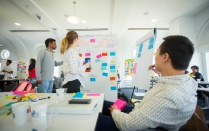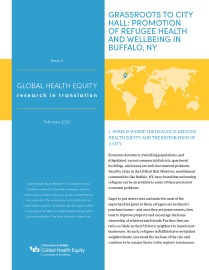Issue 5
Grassroots to City Hall: Promotion of Refugee Health and Wellbeing in Buffalo, NY
Global Health Equity Research in Translation brings academic research to broader audiences: decision makers, policy makers, advocacy groups, philanthropists, and journalists. The series draws on transdisciplinary health equity research completed with the support of the Community of Excellence in Global Health Equity at the University at Buffalo, The State University of New York.
The 5th Issue of the Global Health Equity Research in Translation Series explores practical advice and policy recommendations from the 2019 Western New York Refugee Health Summit, an annual event co-sponsored by the UB Community for Global Health Equity and the School of Public Health and Health Professions.
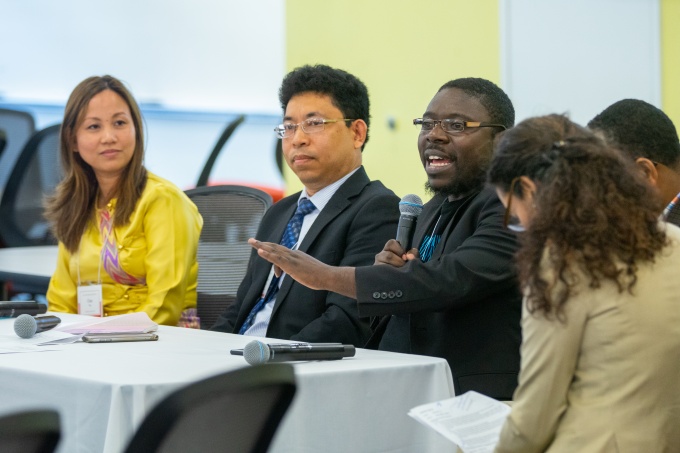
Theo Herman speaking at the Keynote Panel | Western New York Refugee Health Summit 2019 | Pictured, from left to right: Chan Myae Thu, Steven Sanyu, Theo Herman, Abdi Farrah, and Samina Raja | Credit: Douglas Levere | University at Buffalo
I. HOME IS WHERE THE HEALTH IS: REFUGEE HEALTH EQUITY AND THE RESTORATION OF A CITY
Economic downturn, dwindling populations, and dilapidated, vacant commercial districts, apartment buildings, and homes are well-documented problems faced by cities in the US Rust Belt. However, resettlement communities like Buffalo, NY, have found that welcoming refugees can be an antidote to some of these persistent economic problems.
Eager to put down roots and make the most of the opportunities given to them, refugees are inclined to purchase homes—and once they are home owners, they tend to improve property and encourage the home ownership of relatives and friends. Further, they are twice as likely as their US-born neighbors to launch new businesses. As such, refugees in Buffalo have revitalized neighborhoods, increased the tax base of the city, and continue to be a major factor in the region’s renaissance.
While refugees are helping to bring Buffalo back to life, how well are the health needs of refugees being met by the local health and housing systems of Buffalo? In particular, what kinds of strategies are in place to address the mental health needs of refugees who have resettled in Buffalo? In the spring of 2019, these questions were explored at the annual Western New York Refugee Health Summit.1
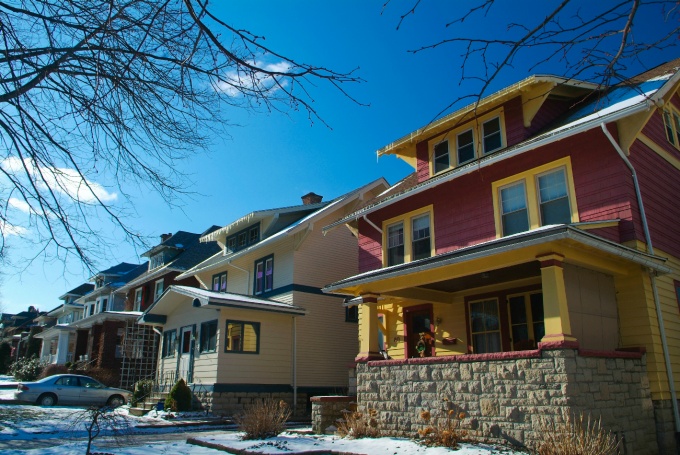
Housing in Buffalo | Credit: Douglas Levere | University at Buffalo
The challenges. Displaced from their homes by armed conflict, political persecution, or natural disaster, refugees contend with trauma that can continue through the resettlement process. Though “safe” in the US, resettled people can experience social isolation, culture shock, unmet expectations, and discrimination, all powerful stressors that can contribute to poor mental health outcomes. As a further complicating factor, refugees bring with them the beliefs and practices of their home communities, and in many cultures, mental health challenges are considered taboo.
Additionally, it is well established that our homes, neighborhoods, and the greater built environment in which we live are all powerful social determinants of health, and directly influence individual and community health outcomes. Much of Buffalo’s aging—but inexpensive—housing stock has not been well maintained. Substandard and unsafe heating systems and antiquated, paint-sealed windows that make summer heat unbearable are common, as are interior and exterior lead paint, and infestations of insects and vermin. Because refugees initially have limited income, little or no knowledge of local health and housing codes, and language and literacy barriers, they are at risk of beginning their lives in Buffalo in housing that might compromise their health and wellbeing.
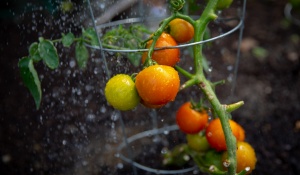
Tomatoes growing in community garden | Credit: Meredith Forrest Kulwicki | University at Buffalo
Homegrown solutions. In Buffalo and Western New York, a number of community-based organizations provide refugees with trauma-informed mental health counseling and support services. For example, BestSelf Behavioral Health employs refugees to serve as counselors, interpreters, and patient advocates for other refugees, which helps clients to feel—and be—fully understood. Grassroots Gardens of Western New York advocates for community gardens to improve the built environment of the Buffalo-Niagara region while enhancing the health of its residents. These community gardens ameliorate food security, create a physical point of contact for neighbors to interact with one another and the earth, and enable the cultivation of foods that refugees and immigrants loved in their home countries—all of which promote wellbeing. Additionally, to combat resistance to mental health care, some religious leaders use their platform in the community to promote therapies ranging from mindfulness meditation to counseling to specific religious practices.
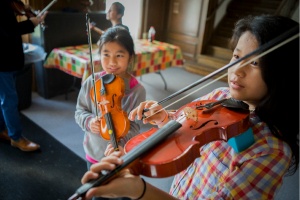
Children practicing violin at Buffalo String Works | Credit: Douglas Levere | University at Buffalo
Children are not immune to stress and trauma, of course. PS 207 Lafayette International High School—a public school attended by many students from immigrant and refugee households—understands that disciplinary procedures need to take into account the life experiences of its students. Thus, school leadership incorporates restorative justice techniques that use conflicts as teachable moments and opportunities for healing. After school programs can also help build friendships and soothe anxiety experienced by refugee schoolchildren. Case in point, Buffalo String Works, a grassroots not-for-profit organization, provides instruments, weekly music lessons, and opportunities for children to perform locally and internationally.
Housing discrimination and evictions can disproportionately impact refugees and immigrants, and Buffalo has a number of grassroots and policy mechanisms to contend with this inequity. Immediate and longer-term housing challenges faced by resettling refugees are addressed by the International Institute, which, as a resettlement agency, arranges housing for families upon their arrival in Buffalo. Additionally, the International Institute provides information in translation that covers common housing challenges faced by Refugees, as well as tactics for effectively communicating about these issues to landlords. Housing Opportunities Made Equal provides no-cost, comprehensive services for people who have experienced housing discrimination. The City of Buffalo Urban Renewal Agency (BURA) aims to promote social and economic change through inclusive revitalization of the City; its website provides information about fair housing, housing discrimination, and landlord and tenant rights translated into a number of languages. Finally, the Partnership for the Public Good—a non-profit think tank that provides research and advocacy for Buffalo-Niagara region community-based organizations—is working with stakeholders and county and municipal officials to develop eviction policies and procedures that contemplate the experience and perspectives of diverse populations.
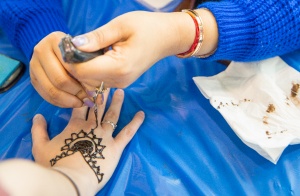
Henna at the University at Buffalo's World Bazaar | Credit: Douglas Levere
In addition to one’s home and immediate neighborhood, the surrounding “built environment” of a city also has an impact on health and wellbeing. The social, economic, mental and physical well-being of refugees can be stimulated by providing what University at Buffalo Assistant Professor of Architecture Erkin Özay calls “landscapes of arrival,” which include access to services, housing, and “spaces for cooperation.” The research of Yeeli Mui —Assistant Professor at Johns Hopkins Bloomberg School of Public Health and affiliate of the Food Systems Planning and Healthy Communities Lab at UB—has found that involving residents of Baltimore, MD in the planning and decision-making of that city’s redevelopment and revitalization efforts positively contributed to residents’ mental health outcomes.
Policy leaders, advocates, and the society at large can support the health and wellbeing of refugees in a variety of ways.
II. PRACTICAL TAKEAWAYS
- To increase understanding of mental health issues, religious leaders and health care providers can routinely address the importance of mental health in public and private settings.
- While establishment and maintenance of trust is central to all therapeutic relationships, they are especially key for mental health practitioners who work with refugees. Trust must be carefully cultivated to understand refugees’ beliefs and concerns about mental health, as well as their expectations for therapy.
- When the opportunity arises, employers, neighborhood associations, community organizers, and members of the resettled refugee community can start conversations and model behavior that promotes mutual understanding among people of divergent experiences and backgrounds.
III. POLICY TAKEAWAYS
- Block clubs, neighborhood associations, cooperative housing, restorative circles, and other forms of coalitions and collective organizations, all have the capacity to combat social isolation and cultivate feelings of belonging in refugees. Existing and emerging community-based organizations and coalitions can be strengthened with small infusions of municipal grants and technical support to extend their reach.
- The City of Buffalo and BURA’s outreach efforts to involve residents in housing code enforcement and other planning decisions can contribute to positive health outcomes for refugees as well as the entire community, and should therefore continue to be supported and amplified.
- The Society for the Advancement of Construction-Related Arts (SACRA), a nonprofit organization, builds local capacity in the trades: trainees gain on-the-job experience while remediating derelict local properties. Among many other benefits, this organization provides the type of community involvement and social interaction that can cultivate wellbeing in the refugee community. The City of Buffalo could contribute to urban revitalization, provide refugees with future livelihood, and foster refugee well-being by alerting people in the resettled refugee community to construction skills training programs like that offered by SACRA. For example, the Office of New Americans might incorporate links to SACRA and other training programs on its website, or ask an AmeriCorp VISTA staff member to develop a multilingual marketing campaign about such opportunities.
- When the opportunity arises, law enforcement officers can start conversations and model behavior that promotes mutual understandingamong people of divergent experiences and backgrounds.
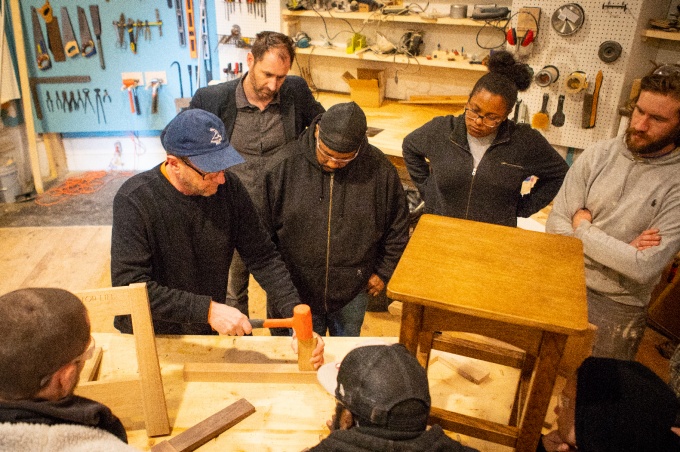
SACRA skill training at Assembly House 150 | Credit: Meredith Forrest Kulwicki| | University at Buffalo
ACKNOWLEDGEMENTS
This brief is extracted from Housing for Refugee Health and Wellbeing: A Summary and Recommendations. 6th annual WNY Refugee Health Summit, prepared by the Community for Global Health Equity in collaboration with the School of Public Health and Health Professions, University at Buffalo. The Sixth Annual Western New York Refugee Health Summit - Housing for Refugee Health and Wellbeing: A Summary and Recommendations. April 13th, 2019.
AUTHOR
Dr. Lisa Vahapoğlu
RECOMMENDED CITATION
“Grassroots to City Hall: Promotion of Refugee Health and Wellbeing in Buffalo, NY.” Global Health Equity Research in Translation. Eds. Frimpong Boamah, Kordas, and Raja. Community of Excellence in Global Health Equity, February 2020.
SOURCE TEXT
Scates, J; Almeter, K; Martinez, A. Housing for Refugee Health and Wellbeing: A summary and Recommendations. 6th annual WNY Refugee Health Summit. Community for Global Health Equity in collaboration with the School of Public Health and Health Professions, University at Buffalo. Published online.
SERIES EDITORS
Dr. Emmanuel Frimpong Boamah, Dr. Katarzyna Kordas, and Dr. Samina Raja
DESIGN AND PRODUCTION
Nicole Little and Jessica Scates
Footnotes
[1] For a research-based exploration of the extent to which local governments consider the needs of refugee populations in formulating planning decisions, using Buffalo as a case study, see Alexandra Judelsohn, Heather Orom, Daniela Leon & Samina Raja (2020) Refuge in new food environments? The role of urban planning in facilitating food equity for new Americans, Journal of Urban Affairs, DOI: 10.1080/07352166.2019.1705845.
